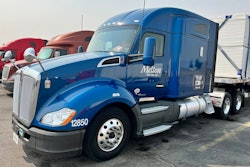How much does it pay? That’s the question at the forefront of every job candidate’s mind when they’re considering new employment, and it’s always a hot topic in the trucking field as the industry strives to attract and retain drivers.
According to a recent trends report from WorkHound, pay was once again a top critical theme – a comment in which drivers explicitly state in a survey their intention or desire to leave a company – in 2022, accounting for 20.2% of all critical feedback received through the platform. That’s compared to 17.2% in 2021.
It's difficult to maintain a consistent driver roster in good times, much less in 2022 as the economy has faced a downturn that further exacerbates carriers’ inabilities to increase wages for their most important assets: drivers.
CCJ recently wrapped its annual What Drivers Want survey – a poll of independent and company drivers – which includes their attitudes toward pay, respect, home time and more. Stay tuned for our reporting.
While pay may appear to be the primary reason drivers look to leave, the survey found there are subthemes underlying pay that are driving drivers into the arms of other carriers.
Only 26.6% of drivers cited pay as the sole reason they were leaving, suggesting it isn’t the ultimate “make or break” issue that causes drivers to leave, but is a pivotal factor when other issues arise.
Those factors include equipment (11.8%), as recent supply chain and manufacturing challenges have created significant new tractor and tractor parts procurement issues, resulting in new truck orders being delayed; logistics issues (17.6%) such as consumer spending changes resulting in surplus inventory, decreased container imports, higher fuel prices and decreased freight volumes; and communication and people rounding out the top five critical comments.
What factors are within the control of carriers to help alleviate a difficult pay environment?
While equipment and logistics issues are, for the most part, out of carriers’ control, communication and people aren’t. That comes down to company culture, which I would argue is the key ingredient in retention.
Work Hound found that frustration for drivers often stems from difficulty in understanding certain aspects of pay such as pay structure, detention pay, breakdown pay, PTO, etc., but it goes beyond that. Communication, which as a subtheme of critical pay feedback accounts for 16.7% of comments, is key on multiple other levels, from transparency in relaying job functions and expectations of a driver to having a clear, easy-to-use, reliable platform/avenue for drivers to share their comments and concerns.
Like any other job, applicants want to have a clear understanding of what their role and compensation will be, and it’s important for carriers to communicate that effectively, which also would help with retention.
I personally want to understand the benefits, perks, bonuses, etc. because, for me, those are factored into my decision to accept a job. For instance, no one wants to leave a job that pays slightly more just to find out that their insurance costs will make that pay raise inconsequential.
That communication contributes to company culture, and carriers should communicate that culture to potential drivers as they would a benefits package because a good culture is part of those benefits.
I don’t care how much money you pay me; if I don’t feel respected and appreciated, I’m not staying long term. I’ve personally experienced an intensely uncomfortable work culture with a former boss who yelled at and talked down to his employees all the time. I left less than three months in with nothing else lined up, despite needing the money, which – at the time – was the most I’d ever made.
I think that’s true for any job, but especially for truck drivers.
From my time working in this industry, I’ve come to understand that respect, understanding and appreciation are also highly valued among the proud population that is truck drivers.
That leads into the people element.
People as a subtheme of critical pay feedback accounts for 12.8% of comments. According to the survey, drivers understand planning and scheduling issues are an inherent part of the job, but their problem lies in issues like favoritism, attitude or other adverse treatment from office personnel as a reason they want to leave. Drivers feel demoralized and become disillusioned when the source of guidance/help injects unnecessary negativity into an already stressful situation.
And the holidays are even more stressful for most people as their already busy schedules and to-do lists ramp up but especially for drivers who are working to deliver the additional goods in demand at this time of year. They’re also away from their families during a season that is centered around family time.
But a culture of kindness and caring goes a long way year-round, not just at Christmas. So be sure you’re training your office staff on best practices when communicating – and I use that word intentionally – at every level with your drivers.













